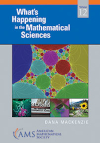- About MAA
- Membership
- MAA Publications
- Periodicals
- Blogs
- MAA Book Series
- MAA Press (an imprint of the AMS)
- MAA Notes
- MAA Reviews
- Mathematical Communication
- Information for Libraries
- Author Resources
- Advertise with MAA
- Meetings
- Competitions
- Programs
- Communities
- MAA Sections
- SIGMAA
- MAA Connect
- Students
- MAA Awards
- Awards Booklets
- Writing Awards
- Teaching Awards
- Service Awards
- Research Awards
- Lecture Awards
- Putnam Competition Individual and Team Winners
- D. E. Shaw Group AMC 8 Awards & Certificates
- Maryam Mirzakhani AMC 10 A Awards & Certificates
- Two Sigma AMC 10 B Awards & Certificates
- Jane Street AMC 12 A Awards & Certificates
- Akamai AMC 12 B Awards & Certificates
- High School Teachers
- News
You are here
What's Happening in the Mathematical Sciences, Volume 12

Buy Now:
Publisher:
AMS
Publication Date:
2022
Number of Pages:
126
Format:
Paperback
Price:
25.00
ISBN:
978-1-4704-6498-1
Category:
General
The Basic Library List Committee suggests that undergraduate mathematics libraries consider this book for acquisition.
[Reviewed by , on ]
Michele Intermont
01/5/2023
A new volume of this series usually sparks a great deal of interest, and this installment deserves to do the same. Dana Mackenzie has once again delivered an interesting collection of topical vignettes on current mathematical research.
Since its inaugural issue in 1993 (authored in the beginning by Barry Cipra), “What’s Happening in the Mathematical Sciences” has written cogently on topics in mathematics for non-specialists. The topics are a nice mix of pure and applied mathematics. This edition is dominated by COVID-related adventures, and while certainly timely, I was a bit tired just looking at the table of contents. But I underestimated Mackenzie. “Fifty Ways to Beat a Virus” came in three parts, and all three articles were fun to read. Each centered on a different aspect of the pandemic, and on a different collection of mathematicians. There are five other chapters in the book, one related to climate change and the others on problems in geometry, topology and number theory.
One of the things this book does best is tell stories, both of people and of problems. For example, in “Square Pegs and Squiggly Holes” we learn the story of the Square Peg Conjecture, first formulated in 1911. This doesn’t sound like a current topic in research, but we are offered a glimpse of the rich body of work done just since the 1980s, and we are introduced to those whose research in the last five years in symplectic geometry has led to new insight on the conjecture. In “Much Ado About Zero” we learn as much about the community of mathematicians and physicists studying the idea of zero-forcing as about the idea itself.
Previous reviewers of this series have commented that the book could be improved by adding a few references for each article. I concur, although I might add that this is the only improvement I can imagine. While an exhaustive list is not necessary, I admit to wanting a few sources as a place to begin a slightly deeper look into some of the topics.
Michele Intermont is an algebraic topologist at Kalamazoo College.
See the publisher's website.
- Log in to post comments




